Review of Recent Progress on Advanced Photocathodes for Superconducting RF Guns
Abstract
:1. Introduction
2. Requirements for Photocathodes Used in SRF Guns
3. Photocathode Assembly
4. Superconducting Photocathodes
4.1. Nb Photocathode
4.2. Pb Layer on Nb
4.3. Nb Cathode with Plasmonic Enhancement
5. Normal Conducting Photocathodes
5.1. Metallic Photocathodes: Cu, Mg
5.2. Cs2Te for HZDR SRF Guns
5.3. Reflection-Mode K2CsSb
5.3.1. K2CsSb in BNL 113MHz SRF Gun
5.3.2. K2CsSb on Mo Plug in PKU SRF Gun
5.3.3. K2CsSb on Mo Plug for HZB SRF Gun
5.4. Transmission-Mode K2CsSb for KEK SRF Gun
5.5. III-V Photocathodes: GaAs, GaN
6. Conclusions and Discussions
Author Contributions
Funding
Data Availability Statement
Acknowledgments
Conflicts of Interest
References
- Chaloupka, H. A Proposed Superconducting Photoemission Source of High Brightness. In Proceedings of the EPAC88, Rome, Italy, 7–11 June 1988; Available online: https://accelconf.web.cern.ch/e88/PDF/EPAC1988_1312.PDF (accessed on 18 June 2022).
- Raubenheimer, T.O. The LCLS-II-HE, A high energy up-grade of the LCLS-II. In Proceedings of the 60th ICFA Advanced Beam Dynamics Workshop on Future Light Sources (FLS’18), Shanghai, China, 5–9 March 2018; pp. 6–11. [Google Scholar]
- Decking, W. A MHz-repetition-rate hard X-ray free-electron laser driven by a superconducting linear accelerator. Nat. Photonics 2020, 14, 391–397. [Google Scholar] [CrossRef]
- Abo-Bakr, M. Status report of the berlin energy recovery linac project BERLinPro. In Proceedings of the 9th International Particle Accelerator Conference (IPAC’18), Vancouver, BC, Canada, 29 April–4 May 2018. [Google Scholar]
- Konomi, T.; Honda, Y.; Kako, E.; Kobayashi, Y.; Michizono, S.; Miyajima, T.; Sakai, H.; Yamaguchi, K.U.S. Development of high intensity, high brightness CW SRF gun in KEK. In Proceedings of the 19th International Conference on RF Superconductivity (SRF 2019), Dresden, Germany, 30 June–5 July 2019. [Google Scholar]
- Hernandez-Garcia, C.; Adderley, P.; Bullard, B.; Benesch, J.; Grames, J.; Gubeli, J.; Hannon, F.; Hansknecht, J.; Jordan, J.; Kazimi, R.; et al. Compact −300 kV dc inverted insulator photogun with biased anode and alkali-antimonide photocathode. Phys. Rev. Accel. Beams 2019, 22, 113401. [Google Scholar] [CrossRef] [Green Version]
- Nishimori, N.; Nagai, R.; Hajima, R.; Yamamoto, M.; Honda, Y.; Miyajima, T.; Uchiyama, T. Operational experience of a 500 kV photoemission gun. Phys. Rev. Accel. Beams 2019, 22, 053402. [Google Scholar] [CrossRef] [Green Version]
- Gu, X.; Altinbas, Z.; Badea, S.; Bruno, D.; Cannizzo, L.; Costanzo, M.; Drees, A.; Fedotov, A.A.; Fischer, W.; Gassner, D.; et al. Stable operation of a high-voltage high-current dc photoemission gun for the bunched beam electron cooler in RHIC. Phys. Rev. Accel. Beams 2020, 23, 013401. [Google Scholar] [CrossRef] [Green Version]
- Sannibale, F.; Fillippetto, D.; Qian, H.; Mitchell, C.; Zhou, F.; Vecchione, T.; Li, R.K.; Giermna, S.; Schmerge, J. High-brightness beam tests of the very high frequency gun at the Advanced Photo-injector EXperiment test facility at the Lawrence Berkeley National Laboratory. Rev. Sci. Instrum. 2019, 90, 033304. [Google Scholar] [CrossRef] [PubMed]
- Zhou, F. Review of CW guns for XFELs. In Proceedings of the ICFA Advanced Beam Dynamics Workshop (FLS’18), Shanghai, China, 5–9 March 2018; JACoW: Geneva, Switzerland, 2018. [Google Scholar]
- Xie, H.; Ben-Zvi, I.; Rao, T.; Wang, T.X. Experimental measurements and theoretical model of the cryogenic performance of bialkali photocathode and characterization with Monte Carlo simulation. Phys. Rev. Accel. Beams 2016, 19, 103401. [Google Scholar] [CrossRef]
- Vogel, E.; Barbanotti, S.; Brinkmann, A.; Iversen, T.B.J. Status of the all superconducting gun cavity at DESY. In Proceedings of the 19th International Conference on RF Superconductivity, Dresden, Germany, 30 June–5 July 2019. [Google Scholar]
- Hannon, F.; Andonian, G.; Harris, L. A Plasmonic niobium photocathode for SRF gun applications. In Proceedings of the 10th International Particle Accelerator Conference IPAC2019, Melbourne, Australia, 19–24 May 2019. [Google Scholar]
- Liu, A.; Kostin, R.; Jing, C.; Avrakhov, P. Optimization of an SRF gun design for UEM applications. In Proceedings of the 3rd North American Particle Accelerator Conference (NAPAC2019), Lansing, MI, USA, 1–6 September 2019. [Google Scholar]
- Teichert, J.; Arnold, A.; Ciovati, G.; Deinert, J.C.; Evtushenko, P.; Justus, M.; Xiang, R. Successful user operation of a superconducting radio-frequency photoelectron gun with Mg cathodes. Phys. Rev. Accel. Beams 2021, 24, 033401. [Google Scholar] [CrossRef]
- Neumann, A.; Böhlick, D.; Bürger, M.; Echevarria, P.; Frahm, A.; Glock, H.-W.; Göbel, F.; Heling, S.; Janke, K.; Jankowiak, A.; et al. The bERLinPro SRF photoinjector system-from first RF commissioning to first beam. In Proceedings of the 9th International Particle Accelerator Conference (IPAC2018), Vancouver, BC, Canada, 29 April–4 May 2018. [Google Scholar]
- PetrushinaI, I.; Litvinenko, V.; Jing, Y.; Ma, J.; Pinayev, I.; Shih, K.; Wang, G.; Wu, Y.; Altinbas, Z.; Brutus, J.; et al. High-brightness continuous-wave electron beams from superconducting radio-frequency photoemission gun. Phys. Rev. Lett. 2020, 24, 244801. [Google Scholar] [CrossRef] [PubMed]
- Legg, R.; Bisognano, J.; Bissen, M.; Bosch, R.; Eisert, D.; Fisher, M.; Green, M.; Jacobs, K.; Kleman, K.; Kulpin, K.; et al. Status of the Wisconsin SRF gun. In Proceedings of the IPAC2012, New Orleans, LA, USA, 20–25 May 2012. [Google Scholar]
- Smedley, J.; Rao, T.; Zhao, Q. Photoemission studies on niobium for superconducting photoinjectors. J. Appl. Phys. 2005, 98, 043111. [Google Scholar] [CrossRef]
- Smedley, J.; Rao, T.; Sekutowicz, J. Lead photocathodes. Phys. Rev. ST Accel. Beams 2008, 11, 013502. [Google Scholar] [CrossRef] [Green Version]
- Barday, R.; Burrill, A.; Jankowiak, A.; Kamps, T.; Knobloch, J.; Kugeler, O.; Matveenko, A.; Neumann, A.; Schmeißer, M.; Voelker, J. Characterization of a superconducting Pb photocathode in a superconducting rf photoinjector cavity. Phys. Rev. Accel. Beams 2013, 16, 123402. [Google Scholar] [CrossRef] [Green Version]
- Lorkiewicz, J.; Nietubyć, R.; Diduszko, R.; Sekutowicz, J.; Kosińska, A.; Mirowski, R.; Kuk, M.; Trembicki, A. Coating in ultra-high vacuum cathodic-arc and processing of Pb films on Nb substrate as steps in preparation of Nb-Pb photocathodes for radio-frequency superconducting e-guns. Vacuum 2020, 179, 109524. [Google Scholar] [CrossRef]
- Zhang, Z.; Li, R.; To, H.; Andonian, G.; Pirez, E.; Meade, D.; Maxson, J.; Musumeci, P. Surface-plasmon enhanced photoemission of a silver nano-patterned photocathode. Nucl. Instrum. Methods Phys. Res. Sect. A Accel. Spectrometers Detect. Assoc. Equip. 2017, 865, 114–118. [Google Scholar] [CrossRef]
- Li, R.K.; To, H.; Andonian, G.; Feng, J.; Polyakov, A.; Scoby, C.M.; Thompson, K.; Wan, W.; Padmore, H.A.; Musumeci, P. Surface-Plasmon Resonance-Enhanced Multiphoton Emission of High-Brightness Electron Beams from a Nanostructured Copper Cathode. Phys. Rev. Lett. 2013, 110, 074801. [Google Scholar] [CrossRef] [PubMed] [Green Version]
- Asalzadeh, S. Strong Plasmonic Enhancement of Photoelectric Quantum Efficiency of Nb Using in Nano Islands; ProQuest Dissertations Publishing: Ann Arbor, MI, USA, 2020. [Google Scholar]
- Teichert, J.; Arnold, A.; Freitag, M.; Lu, P.; Michel, P.; Murcek, P.; Vennekate, H.; Xiang, R.; Kneisel, P.; Will, I. Commissioning of an improved superconducting RF photo injector at ELBE. In Proceedings of the FEL2014, Basel, Switzerland, 30 May 2014. [Google Scholar]
- Gonzalez, L.A.; Angelucci, M.; Larciprete, R.; Cimino, R. The secondary electron yield of noble metal surfaces. AIP Adv. 2017, 7, 115203. [Google Scholar] [CrossRef] [Green Version]
- Hałas, S. 100 years of work function. Mater. Sci. 2006, 24, 4. [Google Scholar]
- Xiang, R.; Arnold, A.; Lu, P.; Murcek, P.; Teichert, J.; Vennekate, H. Study of magnesium photocathodes for superconducting RF photoinjectors. In Proceedings of the 9th International Particle Accelerator Conference (IPAC2018), Vancouver, BC, Canada, 29 April–4 May 2018. [Google Scholar]
- Qian, H.J.; Murphy, J.; Shen, Y.; Tang, C.X.; Wang, X.J. Surface photoemission in a high-brightness electron beam radio frequency gun. Appl. Phys. Lett. 2010, 97, 253504. [Google Scholar] [CrossRef]
- Schreiber, S.; Lederer, S.; Monaco, L.; Sertore, D.; Michelato, P. Update on the lifetime of Cs2Te cathodes operated at the FLASH facility. In Proceedings of the 38th Free Electron Laser Conference, Santa Fe, NM, USA, 20–25 August 2017. [Google Scholar]
- Heßler, C.; Chevallay, E.; Martyanov, M.; Neupert, H.; Nistor, V.; Döbert, S.; Taborelli, M. Study of the performance of Cs2Te cathodes in the PHIN RF photoinjector using long pulse trains. In Proceedings of the 7th International Particle Accelerator Conference, Busan, Korea, 8–13 May 2016. [Google Scholar]
- Wisniewski, E.E.; Antipov, S.P.; Conde, M.E.; Doran, D.S.; Gai, W.; Jing, C.J.; Whiteford, C. Cs2Te photocathode performance in the awa high-charge high-gradient drive gun. In Proceedings of the 6th International Particle Accelerator Conference (IPAC’15), Richmond, VI, USA, 3–8 May 2015. [Google Scholar]
- Terunuma, N.; Murata, A.; Fukuda, M.; Hirano, K.; Kamiya, Y.; Kii, T.; Yang, J. Improvement of an S-band RF gun with a Cs2Te photocathode for the KEK-ATF. Nucl. Instrum. Methods Phys. Res. Sect. A Accel. Spectrometers Detect. Assoc. Equip. 2010, 613, 1–8. [Google Scholar] [CrossRef]
- Loisch, G.; Chen, Y.; Koschitzki, C.; Qian, H.; Gross, M.; Hannah, A.; Weilbach, T. Direct measurement of photocathode time response in a high-brightness photoinjector. Appl. Phys. Lett. 2022, 120, 104102. [Google Scholar] [CrossRef]
- Aryshev, A.; Shevelev, M.; Honda, Y.; Terunuma, N.; Urakawa, J. Femtosecond response time measurements of a Cs2Te photocathode. Appl. Phys. Lett. 2017, 111, 033508. [Google Scholar] [CrossRef] [Green Version]
- Xiang, R.; Arnold, A.; Buettig, H.; Janssen, D.; Justus, M.; Lehnert, U.; Teichert, J. Cs2Te normal conducting photocathodes in the superconducting rf gun. Phys. Rev. Spec. Top. Accel. Beams 2010, 13, 043501. [Google Scholar] [CrossRef] [Green Version]
- Teichert, J.; Arnold, A.; Büttig, H.; Justus, M.; Kamps, T.; Lehnert, U.; Xiang, R. Free-electron laser operation with a superconducting radio-frequency photoinjector at ELBE. Nucl. Instrum. Methods Phys. Res. Sect. A 2014, 743, 114–120. [Google Scholar] [CrossRef]
- Xiang, R.; Arnold, A.; Ma, S.; Michel, P.; Murcek, P.; Schaber, J.; Ryzhov, J.T.A.; Zwartek, P. Study of QE evolution of Cs2Te photocathodes in ELBE SRF GUN-II. In Proceedings of the IPAC2022, Bangkok, Thailand, 12–17 June 2022. [Google Scholar]
- Fisher, D.G.; McDonie, A.F.; Sommer, A.H. Band-bending effects in Na2KSb and K2CsSb photocathodes. J. Appl. Phys. 1974, 45, 487–488. [Google Scholar] [CrossRef]
- Feng, J.; Karkare, S.; Nasiatka, J.; Schubert, S.; Smedley, J.; Padmore, H. Near atomically smooth alkali antimonide photocathode thin films. J. Appl. Phys. 2017, 121, 044904. [Google Scholar] [CrossRef]
- Petrushina, I.; Belomestnykh, S.A.; Kazakov, S.; Khabiboulline, T.N.; Martinello, M.; Pischalnikov, Y.M.; Yakovlev, V.P.; Brutus, J.C.; Inacker, P.; Jing, Y.C.; et al. Superconducting RF gun with high current and the capability to generate polarized electron beams. In Proceedings of the IPAC 21, Campinas, SP, Brazil, 24–28 May 2021. [Google Scholar]
- Wang, E.; Litvinenko, V.N.; Pinayev, I.; Gaowei, M.; Skaritka, J.; Belomestnykh, S.; Wu, Y. Long lifetime of bialkali photocathodes operating in high gradient superconducting radio frequency gun. Sci. Rep. 2021, 11, 1–9. [Google Scholar] [CrossRef]
- Xie, H. The Cryogenic operation of K2CsSb photocathode in the DC-SRF photoinjector at PKU. In Proceedings of the Oral Talk in Photocathode Physics for Photoinjectors Workshop (P3 WORKSHOP) 2021, Online Zoom Meeting, 10–12 November 2021. [Google Scholar]
- Ouyang, D.; Zhao, Y.; Xie, H.; Zhang, X.; Zhao, S.; Feng, L.; Liu, K.; Huang, S. Performance of bialkali photocathode in DC-SRF photoinjector. Nucl. Instrum. Methods Phys. Res. Sect. A Accel. Spectrometers Detect. Assoc. Equip. 2021, 1026, 166204. [Google Scholar] [CrossRef]
- Kühn, J.; Al-Saokal, N.; Bürger, M.; Dirsat, M.; Frahm, A.; Jankowiak, A.; Kamps, T.; Klemz, G.; Neumann, S.M.A.; Ploetz, H. Thermal load studies on the photocathode insert with exchangeable plug for the BERLinPro SRF-photoinjector. In Proceedings of the 19th International Conference on RF Superconductivity (SRF’19), Dresden, Germany, 30 June–5 July 2019. [Google Scholar]
- Schmeißer, M.; Mistry, S.; Kirschner, H.; Schubert, S.; Jankowiak, A. Towards the operation of Cs-K-Sb photocathodes in superconducting rf photoinjectors. Phys. Rev. Accel. Beams 2018, 21, 113401. [Google Scholar] [CrossRef] [Green Version]
- Schmeisser, M. Photocathodes for High Brightness, High Average Current Photoelectron Injectors. Ph.D. Thesis, Humboldt-Universität zu Berlin, Berlin, Germany, 2019. [Google Scholar]
- Konomi, T.; Honda, Y.; Kako, E.; Kobayashi, Y.; Michizono, S.; Miyajma, T.; Sakai, H.; Umemori, K.; Matsuda, R.; Yanagisawa, T. Development of SRF gun applying new cathode idea using a transparent superconducting layer. In Proceedings of the 59th ICFA Advanced Beam Dynamics Workshop on Energy Recovery Linacs (ERL17), Geneva, Switzerland, 18–23 June 2017. [Google Scholar]
- Wang, E.; Kewisch, J.; Ben-Zvi, I.; Burrill, A.; Rao, T.; Wu, Q. Quantum efficiency temporal response and lifetime of a GaAs cathode in SRF electron gun. In Proceedings of the First International Particle Accelerator Conference, Kyoto, Japan, 23–28 May 2010. [Google Scholar]
- Wang, E.; Kewisch, J.; Ben-Zvi, I.; Burrill, A.; Rao, T.; Wu, Q.; Holmes, D. Testing a GaAs cathode in SRF gun. In Proceedings of the 2011 Particle Accelerator Conference (PAC’11), New York, NY, USA, 28 March–1 April 2011. [Google Scholar]
- Wang, E.; Wang, E. High Quantum Efficiency Photocathode for Use in Superconducting RF Gun. Ph.D. Thesis, School of Physics, Peking University, Beijing, China, 2012. [Google Scholar]
- Cultrera, L.; Rocco, E.; Shahedipour-Sandvik, F.; Bell, L.; Bae, J.K.; Bazarov, I.V.; Saha, P.; Karkare, S.; Arjunan, A. Photoemission characterization of N-polar III-nitride photocathodes as candidate bright electron beam sources for accelerator applications. J. Appl. Phys. 2022, 131, 124902. [Google Scholar] [CrossRef]
- Schaber, J.; Xiang, R.; Teichert, J. The attempt of using (Cs: O) GaAs and (Cs) GaN as photocathodes in SRF photoinjectors. Verh. Der Dtsch. Phys. Ges. 2019, 50. [Google Scholar]
- Schaber, J.; Xiang, R.; Teichert, J.; Arnold, A.; Murcek, P.; Zwartek, P.; Ryzhov, A.A.; Ma, S.; Gatzmaga, S.; Michel, P.; et al. Influence of Surface Cleaning on Quantum Efficiency, Lifetime and Surface Morphology of p-GaN: Cs Photocathodes. Micromachines 2022, 13, 849. [Google Scholar] [CrossRef]
- Jensen, K.; O’Shea, P.G.; Feldmsan, D.W. Emittance of a photocathode: Effects of temperature and field. Phys. Rev. Accel. Beams 2010, 13, 080704. [Google Scholar] [CrossRef]
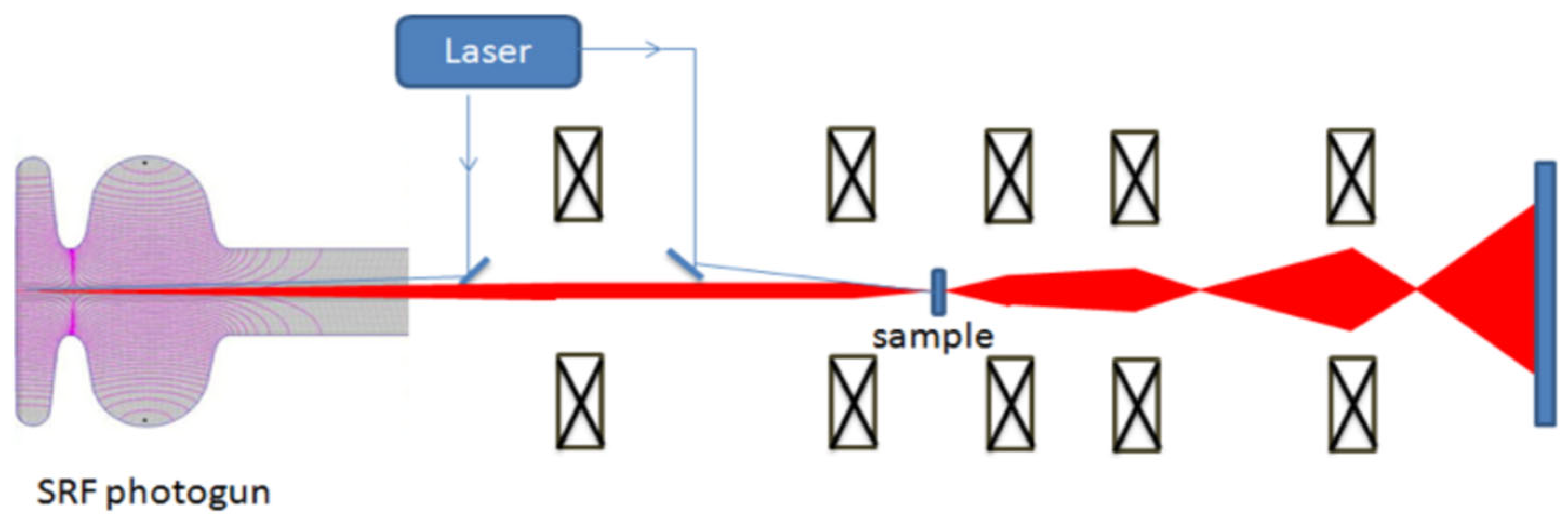

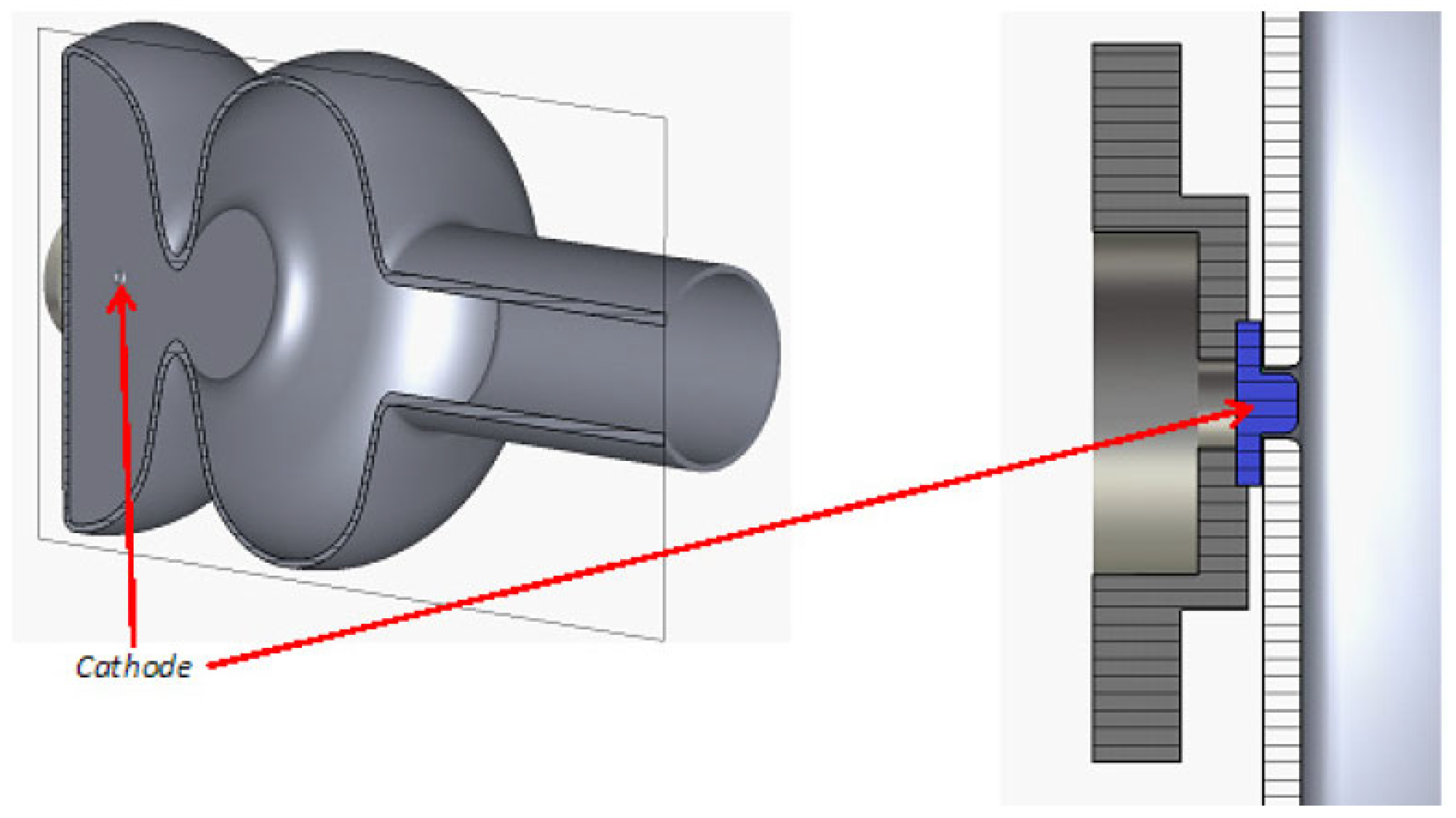

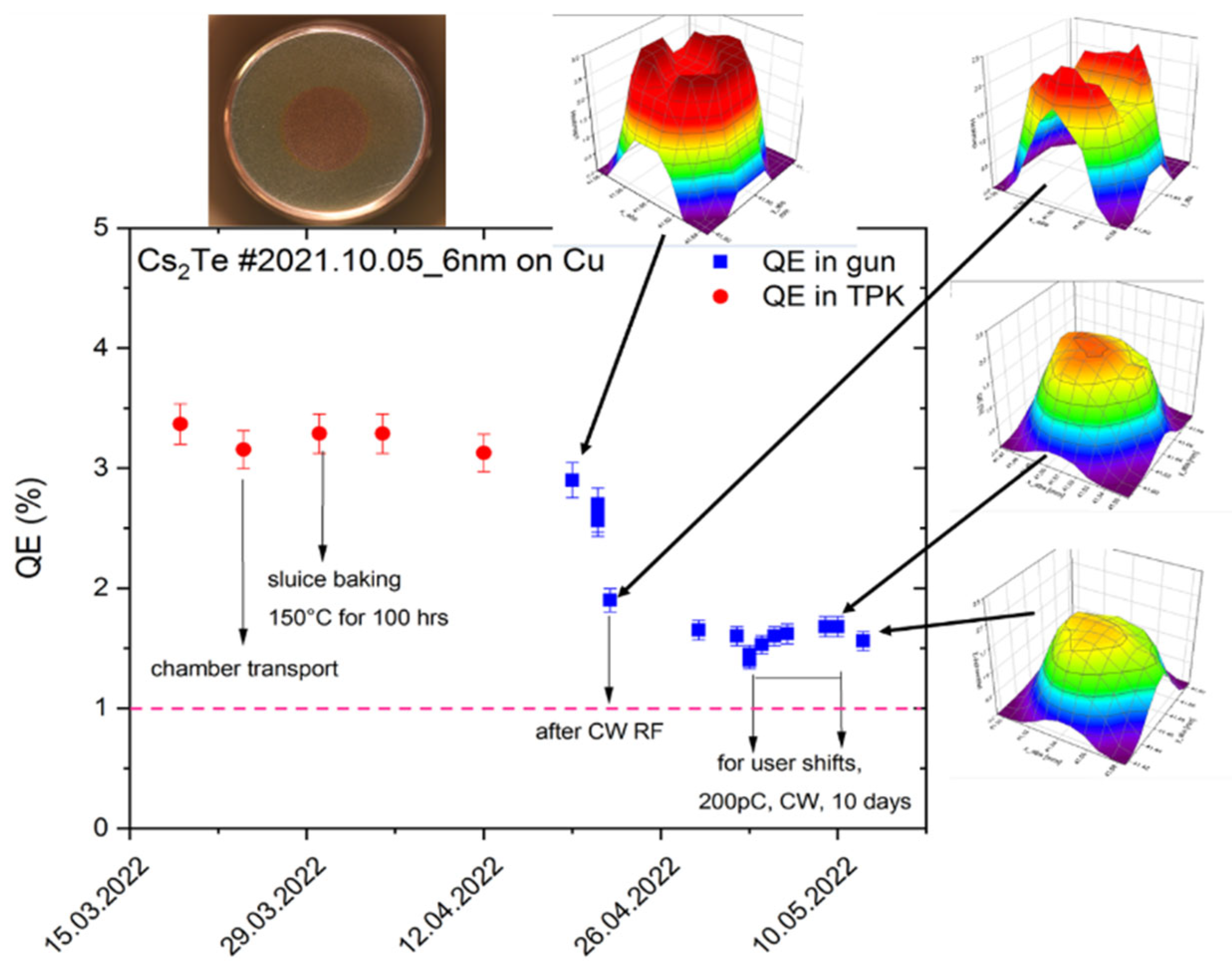

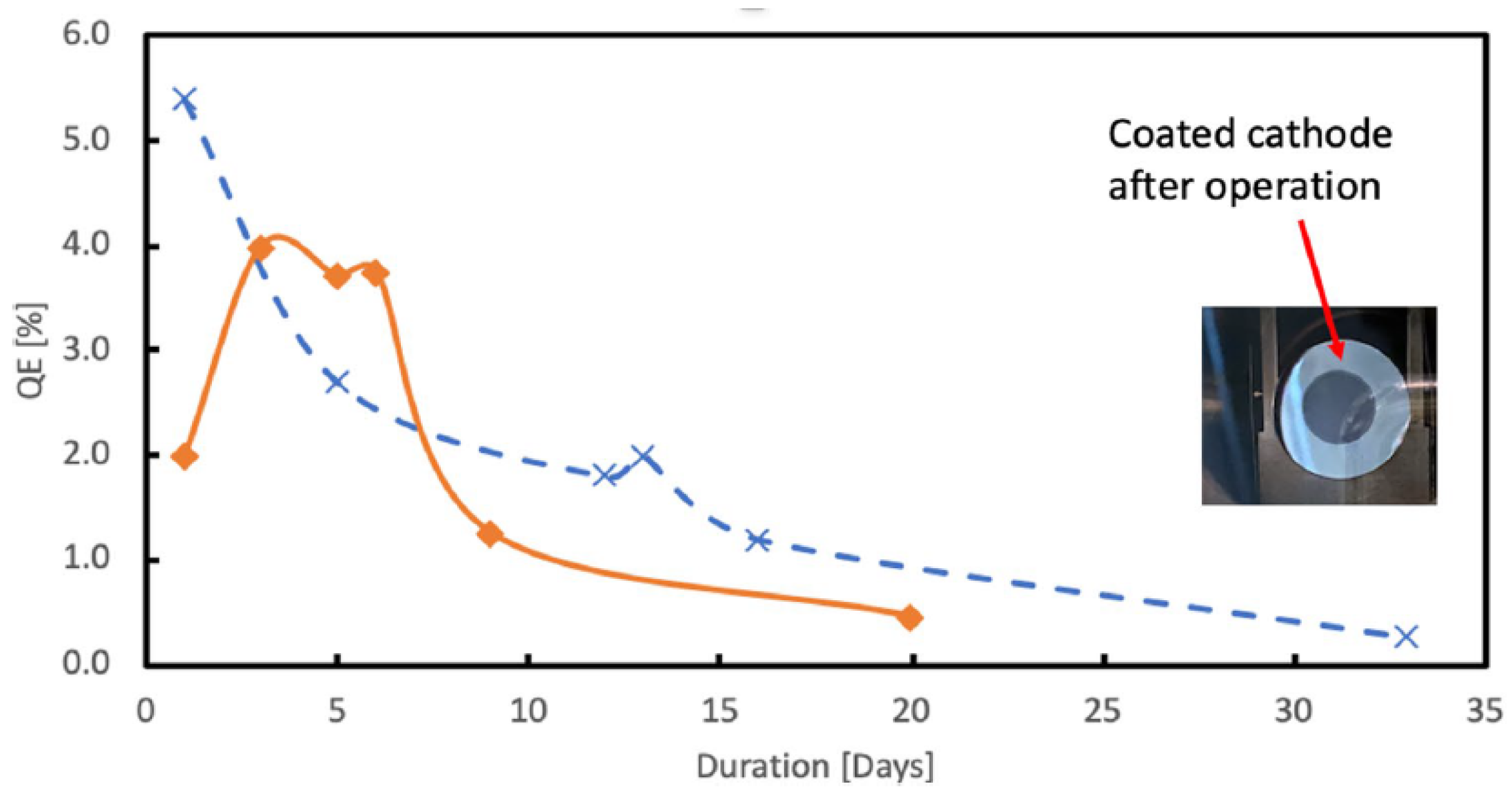


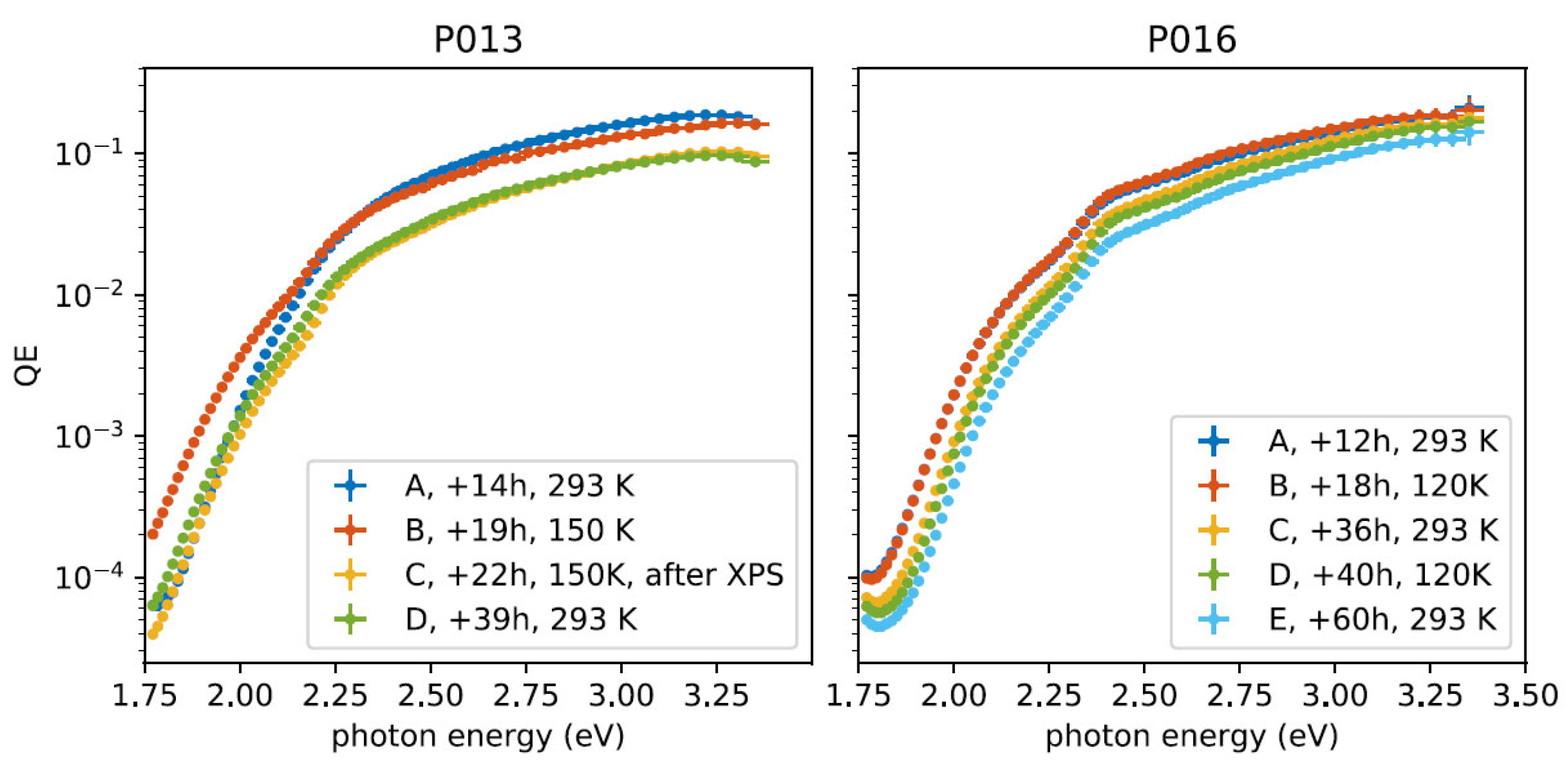
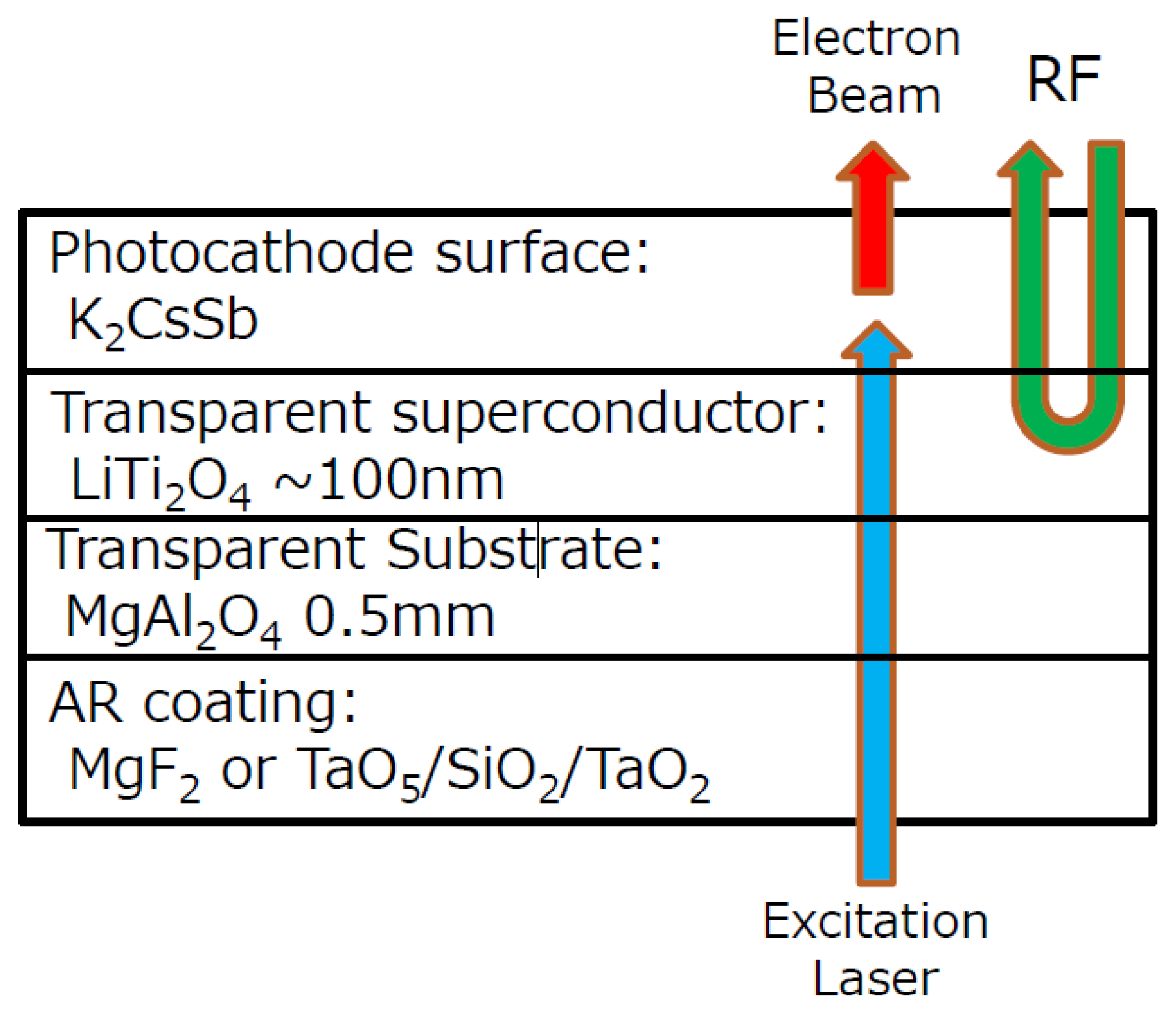
| Metal | QE | ϕ (eV) [28] |
|---|---|---|
| Cu | 10−5–10−4 | 4.6 |
| Mg | 10−5–10−3 | 3.6 |
| Nb | 10−6–10−4 | 4.3 |
| Pb | 10−6–10−3 | 4.0 |
| Cathode Material | Cathode Type | Drive Laser (nm) | Quantum Efficiency in Operation | Lifetime | Extracted Bunch Charge | Operation Temperature | Ref. |
|---|---|---|---|---|---|---|---|
| Nb | SC metal | 266 | 10–5 * | No limit * | <1 pC ** | 4 K | Euclid [14] JLab [19] |
| Pb | SC metal | 213 | 10–4–10–3 * | Year * | 20–250 pC ** | 2 K | DESY [12,22] |
| Pb | SC metal | 258 | 9 × 10–5 | 100 pC ** | 1.8 K | HZB [21] | |
| Plasmonic Nb | SC | 1030 | 1.4 × 10–5 * | 2 K | Jlab [13] | ||
| Cu | NC metal | 258 | 10–5 | No limit | ~1 pC | 80 K | HZDR [26] HZB [16] |
| Mg | NC metal | 262 | 10–3 | year | 250 pC | 80 K | HZDR [26] |
| Cs2Te | Semiconductor | 262 | 1~3% | ~3 months | 300 pC | 80 K | HZDR [39] |
| K2CsSb | Semiconductor | 532 | 5–10% | >1 month | 19.7 nC | 300 K | BNL [42,43] |
| K2CsSb | Semiconductor | 519 | 0.3% | 100 pC | 36 K | PKU [44,45] | |
| K2CsSb | Semiconductor | 515 | 0.7–5% * | 5 days | 77 pC ** | 80 K | HZB [46,47,48] |
| K2CsSb Transmission-mode | Semiconductor | 532 | ~2% * | 80 pC ** | 2 K | KEK [5,49] | |
| GaAs | III-V semiconductor | 532 | 0.7% * | 2 K | BNL [50,51,52] | ||
| GaN | III-V semiconductor | 310 ** | >1% * | 80 K | HZDR [54,55] |
Publisher’s Note: MDPI stays neutral with regard to jurisdictional claims in published maps and institutional affiliations. |
© 2022 by the authors. Licensee MDPI, Basel, Switzerland. This article is an open access article distributed under the terms and conditions of the Creative Commons Attribution (CC BY) license (https://creativecommons.org/licenses/by/4.0/).
Share and Cite
Xiang, R.; Schaber, J. Review of Recent Progress on Advanced Photocathodes for Superconducting RF Guns. Micromachines 2022, 13, 1241. https://doi.org/10.3390/mi13081241
Xiang R, Schaber J. Review of Recent Progress on Advanced Photocathodes for Superconducting RF Guns. Micromachines. 2022; 13(8):1241. https://doi.org/10.3390/mi13081241
Chicago/Turabian StyleXiang, Rong, and Jana Schaber. 2022. "Review of Recent Progress on Advanced Photocathodes for Superconducting RF Guns" Micromachines 13, no. 8: 1241. https://doi.org/10.3390/mi13081241
APA StyleXiang, R., & Schaber, J. (2022). Review of Recent Progress on Advanced Photocathodes for Superconducting RF Guns. Micromachines, 13(8), 1241. https://doi.org/10.3390/mi13081241






